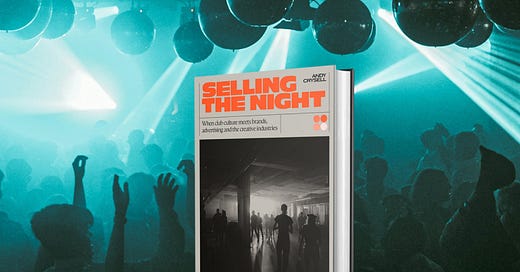Brands Have Been Wedging Their Way into Dance Music for Decades. Andy Crysell Wrote a Book About It.
An interview with the UK writer and longtime marketing professional, who details the longstanding relationship between brands and the dancefloor—and what it means for the culture at large.
Dance music loves to tout its “underground” credentials and its roots in marginalized cultures, but the genre is also the foundation of a global, multibillion-dollar industry. And like anything involving that much capital—and that many potential consumers—dance music has attracted the interest of brands, all of them looking to either grab a slice of the pie or sell something to the genre’s sizable fanbase. In 2025, their presence in the culture is pervasive, and not just at clubs, festivals and other live events. Brands have infiltrated the music media—and in some cases, are actively funding the creation of editorial content—and have also cultivated relationships with artists big and small, many of whom openly flout their sponsorship deals online.
Discussions of this phenomenon often frame it as a relatively new phenomenon, but Selling the Night, a new book by Andy Crysell, paints a more complicated story. The London native is in a good position to do so, as he was first swept into dance music by the acid house boom that hit the UK during the late ’80s. Still a teenager at the time, he quickly threw himself headlong into the genre, throwing parties, working at a record shop and even securing himself a record deal before finally carving out a niche as a music journalist. Crysell spent most of the ’90s writing about dance music for magazines like i-D, The Face, Mixmag, DJ Mag and Muzik, watching first hand as a rapidly commercializing culture birthed superclubs, festivals and unexpected chart hits. In the 2000s, he took a very brief foray into the world of dot coms, but when the place he was working went belly up, he pivoted into marketing, launching—and subsequently selling—two different agencies that put him in direct contact with a litany of globally recognized brands.
Countless people have worked on what might be described as the culture side of dance music (e.g. artists, promoters, labels, journalists), and plenty of others have worked on the brand side, but Crysell is the rare figure with extensive experience in both spheres. So when his time at his second agency came to an end last year, he decided to call upon the wealth of knowledge he’d picked up over the course of his varied career and write a book. Selling the Night chronicles the history of brands in dance music—a history that, as it turns out, goes back decades—while examining the good, bad and ugly bits of their influence on the culture. And while Crysell’s own experiences color the narrative, it’s a deeply researched work that also draws upon dozens of interviews with artists, academics, industry figures and, yes, culture marketing professionals. (One of those professionals is Red Bull Music Academy co-founder Torsten Schmidt, who gives some of his most extensive on-the-record remarks since the project’s closure in 2019.)
A couple of disclosures: Selling the Night is officially coming out on April 4 via Velocity Press, which also published my own book in 2023, and it spends a fair amount of time talking about RBMA, where I was a contributor and later an employee for several years. Take that as you will, but considering how much editorial real estate First Floor has devoted to the topic of brands in dance music, it’s no surprise that I was interested in talking to Crysell about his new book.
Over the course of a long call between us last weekend, the topic of Red Bull Music Academy (and its lasting impact on the culture marketing field) did feature prominently, but our conversation went much further. Brands may be everywhere in dance music these days, and Crysell openly admits that they have plenty of room to do better, but he makes a solid case that their presence shouldn’t be automatically viewed as a positive or a negative. Along the way, he also cites brands’ longstanding interest in dance music as a testament to nightlife’s inherent creativity and outsized influence, and ponders what will happen to contemporary culture marketing efforts—many of them loudly and specifically focused on supporting marginalized artists and communities in dance music—in the Trump era. In a time when numerous corporations are already voluntarily retreating from campaigns and initiatives that might potentially catch the ire of right-wing critics and ideologues, some sort of major upheaval in the marketing realm has become a very real possibility.
The history of brands in dance music is a long one, and as Selling the Night (and this interview) make clear, it’s more complicated than you might think.




